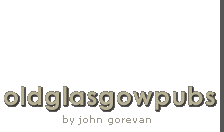Glasgow's Early Tavern's.
For centuries Glasgow's public houses evolved from a typical dwelling house, most of them were very poorly decorated with the minimum of furniture, this meant no carpets or soft furnishings, the occasional ornament displayed on a mantle-piece with a roaring fire in the winter months. The smell of dampness was over whelming along with the smell of stale booze, frequently the stench of urine or something else even more horrific due to the poor ventilation.
A table and chairs were positioned with no covers of cushions or table cloth, no fancy bottles, barrels or glasses were on display, this description of our Glasgow pub continued for centuries. Most of the public houses were kept by a bucksom woman.
Pubs were opened 6 days a week from 8am till 11pm. Sunday drinking was forbidden, but Glasgow drinkers could always have a tipple 7 days a week 24 hours a day if they wanted as many of the pubs then did not stick to the rules. Apart from the public houses in the city, hundreds of shebeens (illegal drinking dens) in the district were big business. Even today I have come across a shebeen in the Parkhead area in the east end of Glasgow. 2009.
A description of a tavern.
One of the better taverns in Glasgow. With a fair linen cloth on the table and a regular score on the wall, and the reckoning, which is two pence halfpenny each, about a penny farthing of our money is collected from the company in a wooden trencher. Such would be a Tavern in Glasgow about the year 1450.
Lets get married in a Glasgow Pub.
Before the mid 18th century, many people were married in pubs. All that was required was a public declarations of consent, a vow before witnesses and consummation, and the marriage was legally binding and permanent. When agreed on the spur of the moment, under the influence of drink, and consummated in the upstairs room of a tavern, many marriages were doomed to failure and unhappiness.
Many poor girls who thought herself wed to the man of her dreams quickly found herself deserted and heart broken. In 1753 under the marriage Act introduced by Lord Hardwicke, it became illegal to be married in pubs and taverns. From that year on it has been necessary to have a marriage licence and for the marriage vows to be given in a place registered for that purpose.
Town Council.
There was some some scandal, so much so that in the end of the seventeenth century the town council was obliged to take up the matter. In the minutes "Several abuses had been committed these several years past by electing and choosing of magistrates and deacon-convenors in the burgh who keped change and publict taverns, which occasioned much debaushire and drunkeness, and poor people to spend their money needlesslie in said taverns. It is there hereby enacted statute and ordained in all tyme comings that nae person or persons be elected and choisen to bear office as Proveist, Baillies, Dean of Guild, Deacon-Convener, Baillie of Gorballs or as Water Baillie, wha Keipis and publict tavern or change house.
Lawyers.
It was owing in part of the restricted house accommodation that taverns were so much frequented by the better classes. Most of the Physicians and Lawyers in large practices were consulted each at his tavern, and gentlemen met there in the evenings at their clubs. In some cases lawyers saw their clients in their own houses. Mr Hutchison, who carried on his business in his own house on the north side of the Trongate, next to the old Tolbooth, probably on the site of what was afterwards the Tontine Exchange and Coffee-room. The house is described "that large neich tenement bak and foir at the corde." Into the interior of this old house before the middle of the 17th century, we have an interesting peep supplied by Mr Hill, Hutchison's business room, situated most likely on the ground floor on the opposite side of the close from the dining-room or entrance hall, there stood a long fixed oak table with his papers at one end and at the other a large silver drinking tankard always replenished with wine or ale for the refreshement of clients.
Merchants.
The principle merchants took an early dinner with their families at home, and then resorted to the coffee-house or tavern to read the newspapers, which they generally did in companies of 4 or 5, in separate rooms over a bottle of claret or a bowl of punch.
Tavern bills were moderate at that time even in the capital. In 1743, there were ordinaries for young gentlemen at 4p a head, for a very good diner of broth and beef and a roast and potatoes, every day, with fish 3 or 4 times a week, and all the small beer that was called for till the cloth was removed.
William Chalmers advertises that he keeps an ordinary at his Poultry and Beef Steak Office opposite the Post Office, Princes Street, where gentlemen will be served with good substantial dinner of fine broth or marrow-bone, soupe and meat both roast and boiled, at the cheap rate of 6d each.
Glasgow Inns
The term "Vintners" first appears in 1734, when £24 10 shillings was paid to Hugh Campbell, vintner, for expenses, by the Provost and Bailie's in connection with a Parliamentary election. Dealers in liquors are in abundance in the first Glasgow Directory of 1783-4, appearing according to importance as Innkeepers, Vintners, Spirit Dealers, Taverns, Maltster's and Change Houses.
Glasgow Hotels
The term "hotel" was first used for the Tontine in 1782, and was usually pronounced "Hottle."
In 1795, the Assembly Rooms, in Ingram Street, were built as a Tontine, with subscriptions of £20 per share. The building latterly became the Athenaeum, and when it was acquired for post office purposes, the main doorway, with window above, was re-erected as the entrance to Glasgow Green at London Street, through the generosity of Bailie James McLennan. In 1816, another Tontine was formed under the name of the Glasgow Tontine Society.
The subscribers included many well-known names not yet forgotten, such as Kirkman Finlay, M.P.: Dr. Cleghorn, Dr. Buchanan, Robert Austin, and Alexander McAslan, still represented by a prominent firm of Seedsmen; Blackburn of Killearn, Harvey of Castlesemple, Henry Montieth of Barrowfield, Maclae of Cathkin, Robert Struthers, Provost of Calton and others. The regulations bore "That the member whose interest shall depend upon the life of the last liver of the whole nominees shall be entitled to the whole property belonging to the Society at the time." There were 800 shares in all, held by 158 proprietors on 442 different lives, while the female nominees were one half more than the male. The properties acquired were (a) the George Inn, George Square; (b) three lodgings in West Nile Street, numbered 48 to 54; (c) a tenement in Wilson Street, with premises at the corner of that street and Glassford Street, now occupied by the New Apothecaries Company and others; and (d) Antigua Place, South Albion Street, the second and third being still held by the Society. When the noninees were reduced to four, their respective interests were pooled, and the funds are now held for the benefit of their successors.
An uncle of mine came to Glasgow in the early part of last century, and taking a walk one Sunday from the foot of Saltmarket to the top of High Street, he counted eighty public houses of various kinds in that one stretch. Trongate, and the streets leading therefrom were simply honey-combed with taverns.
Kent Street
The Scotch Market and Inn in Kent Street survived till the late 60s, and was the disposal centre for all fruit grown within a considerable distance from Glasgow, but ultimately the bazaar, in Candleriggs, proved to be a too powerful opponent. The two-storeyed Inn has disappeared, and while the old gateway and outer wall remain, the site is now occupied by a cartwright, and mainly used as a lock-up for vans and fruit barrows. A feature of the market was Jamie Wallace, with a powerful frame, but only about four feet high. When the P.O. pillar box at the corner of Gallowgate and Kent Street was first opened, Wallace stood for hours commenting on the various letters dropped in, and gravely suggested that a monkey might be put inside and take the letters in its paws.
One of Glasgow's earliest Inns
was the Dove Inn, which stood on the west side of the High Street, a few doors up from George Street. Its date, on deeply-cut stone, now in the Peoples Palace, was 1595 and the building was decorated with a dove, which, like many memorials of city life, has passed beyond human ken. The building was only taken down in 1900.
Landladies
It is surprising in these days of demand for equal treatment of both sexes and for equal pay for equal work, to find the prominence given to women in the management of inns during the past three hundred years or thereby. The following may be recalled:-
Jean McAlpine, Clachan of Aberfoyle in the "Rob Roy."
Meg Dods, Cleikum Inn in "St. Ronan's Well."
Tibbie Shiels, St Marys' Loch.
Possie Nancie, Mauchline.
Mrs Buchanan, Saracen Head.
Mrs Currie, Buck's Head Inn.
Mrs Younghusband, The Star Inn.
Mrs Ralph Erskine, Tavern and Carrier Quarters.
Luckie Black, Tavern and Carrier Quarters.
Mrs Bennie, 2 Great Hamilton Street, who restricted liquor with the remark, "Now, John, you'll get nae mair the nicht; it's time you were hame to Mary."
Mrs Morrison, Corrie, who took a special interest in young clerks and students on the ground that they were none the word of a little mothering when away from home.
Swinging Signs
The Inns signboards of Scotland might be an interesting study. The Black Bull is widespread even in Ayrshire, where the favourite colour is not black, but a mixture of brown and white. There are Golden Lions, Red Lions, Swans, Ships in Seaports, Cross Keys, Wheat Sheaves, White Harts and many other.
Black Boy Tavern & the Elephant Vaults
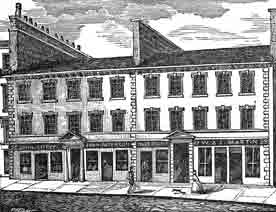
This drawing of a tenement at 27-39 Gallowgate, which was demolished in 1872. The Elephant and the Black Boy Tavern were originally on the ground floor but was converted into shops as shown above.
Grahamston
Outside the city boundary was Grahamston Village, where Central Station now sits. At number 95 Alston Street the main street in Grahamston was the Ancell's Bar named after the Ancell family. The old Tavern was managed by Wullie Wright in the 1840s. The Ancell family continued to serve the locals in Glasgow until the end of that century. The family had connections with the catering and licensed trade in other parts of Glasgow, in 1874 James Ancell a restaurateur was trading at Glassford Street and Andrew Ancell, a wine & spirit merchant traded in Dundas Street. In the village of Grahamston other spirit dealers were James Grant and Robert Bennett at 5 Alston Street in the post-office directory of 1848-49.
Swinging Tavern Signs
The old street signs that were swinging above shops and taverns in the Saltmarket, London Street and Gallowgate had become a problem in 1772, the Town Council attempted to have them removed on the grounds that they interrupted the view along the streets and prevented the proper illumination on the thoroughfares, by shading areas from the sunlight and even from the street lamps. The old swinging signs had another purpose than advertising shops and inns, many a drunken reveller enjoyed swapping them round and vandalising them. It was the next morning that the shop owners found that there shop had a butcher sign above their public house.
Public Inns and Hostels
A statute declared by King James I, on returning from captivity in England in 1442 was that hostels and public Inns were to be provided for the accommodation of traveller's. In Glasgow, the earliest record of an Inn is that of the Dove Inn (1595) which stood on the west side of the High Street. Another old Inn was the Burnt Barns, built in 1679. About the middle of the 18th century, the White Hart Inn, with stables, stood at the Gallowgate corner of the now Ross Street facing the Saracen Head Bar. Behind the Inn was a bowling green and garden. Its first landlord was Robert Tennent, who in 1754 built the first custom-made Inn, the famous Saracen Head Inn, Gallowgate. The first time the word hotel was used in Glasgow was when the Tontine Hotel opened. Although by the beginning of the second half of the 18th century there was quite a few inns in the city, the Magistrates decided that none met the requirements of such an important city. On 24th November 1754, therefore they sold the land of the Kirkyard of little Saint Mungo on the north side of the Gallowgate to Robert Tennent the owner of the White Hart Inn with provisions that he should erect a first-class inn on the site according to an agreed plan.
The Black Bull Inn, Trongate
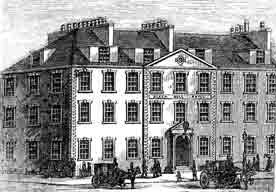
The Black Bull Inn on the Trongate is where Robert Burns wrote to his lover Agnes McIehose.
Andrew Purdon's Tavern
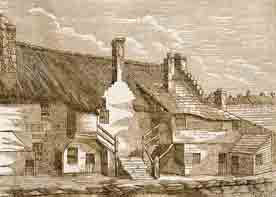
Andrew Purdon's Tavern, Stockwell Street. Cows were milked and supplied to young children.
The Waverley Tavern
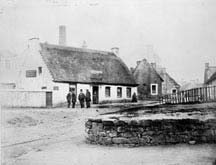
The Waverley Tavern, Water Row, Govan.
The Buck's Head Inn
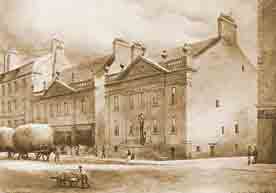
The Buck's Head Inn, Argyle Street at the corner of Dunlop Street, Glasgow.
The Mason Arms Inn, Trongate had a flea circus to entertain the locals.
Robert Jaferay's Wine & Spirit Cellar
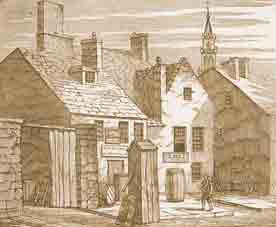
Robert Jaferay's Wine & Spirit Cellar was in Stockwell Street. Number 105 Stockwell Street occupied a cooper and Tavern Keeper.
The Ark, in Partick
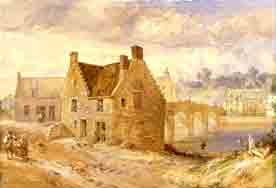
The Ark Inn, Patrick. Viewed from the River Kelvin.
The Star Inn
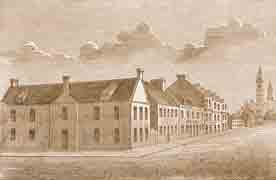
The Star Inn, in the centre of this row of buildings stretching east along Ingram Street.
Penny Ales
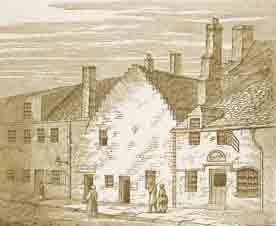
Penny Ales, Stockwell Street, Glasgow.
The Wheat Sheaf Inn
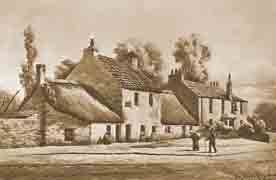
Thomas Fairbairn's painting shows the Wheat Sheaf Inn at the eastern end of Old Dumbarton Road. The Inn was popular with Glaswegian's who walked from the city along Anderston Walk to Partick and the banks of the River Kelvin, to take in the scenery and the country air. It was demolished at the end of the 19th century.
Provan's Lordship the oldest House in Glasgow was an Inn
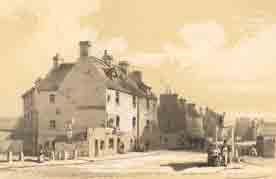
The Provan's Lordship once housed an old Inn known as the Herb Ale House.
The Pointhouse Inn
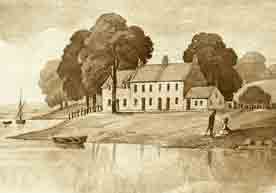
The Pointhouse, an inn and tavern on the east bank of the River Kelvin at its confluence with the Clyde, 1815.
The Clan Inn
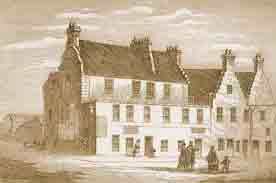
The Clan Inn, Stockwell Street.
Donnelly's Tavern
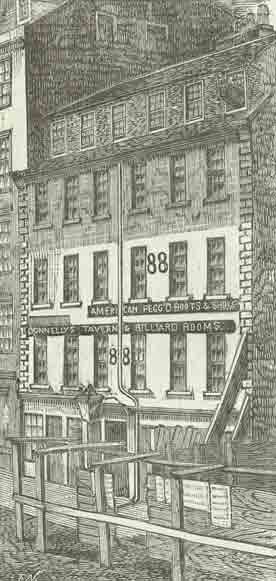
Donnelly's Tavern, Trongate.
Bun House
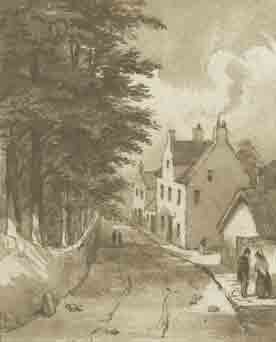
The Bun & Yill House, Old Dumbarton Road, Partick.
Singing Saloons
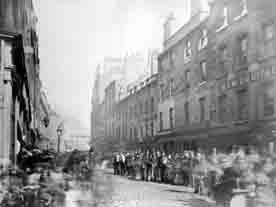
The Singing Saloons on the right of this photograph were notorious drinking dens.
End.
